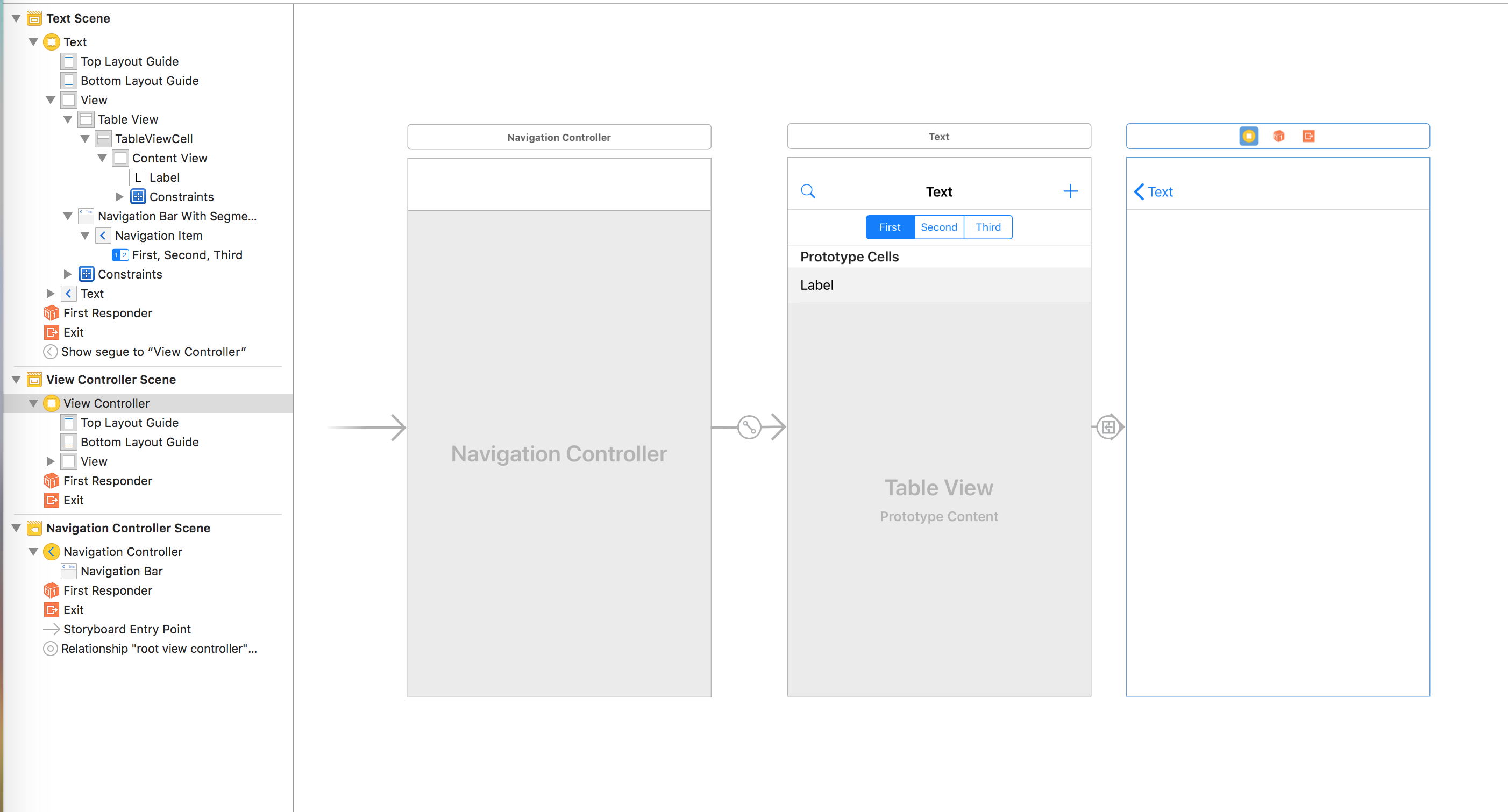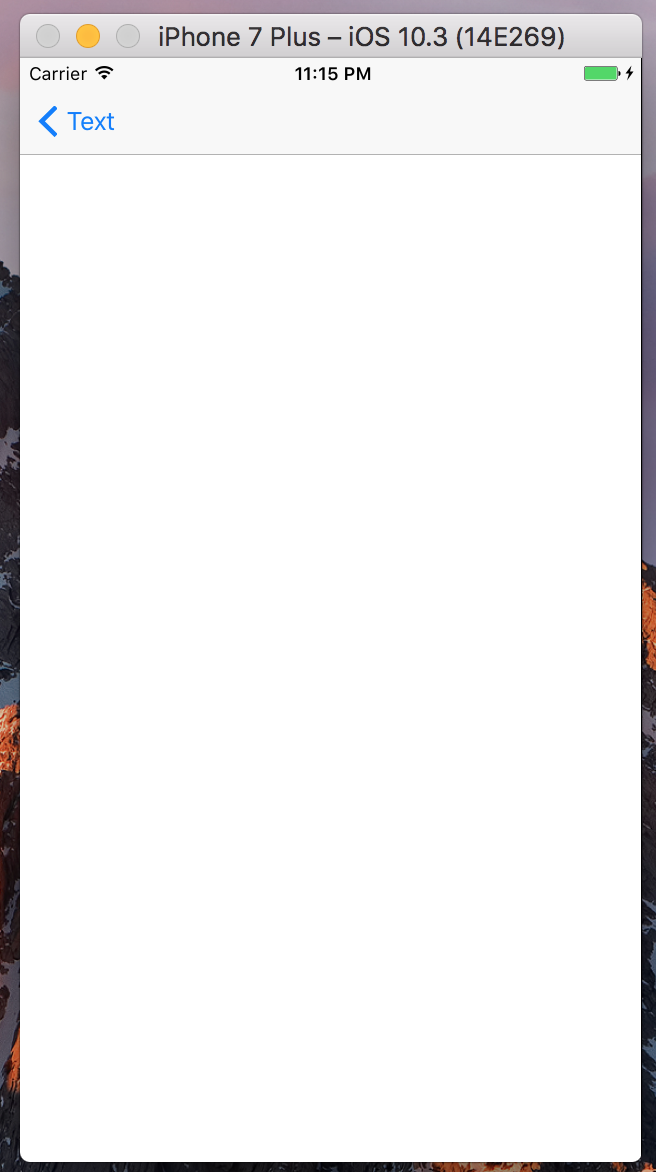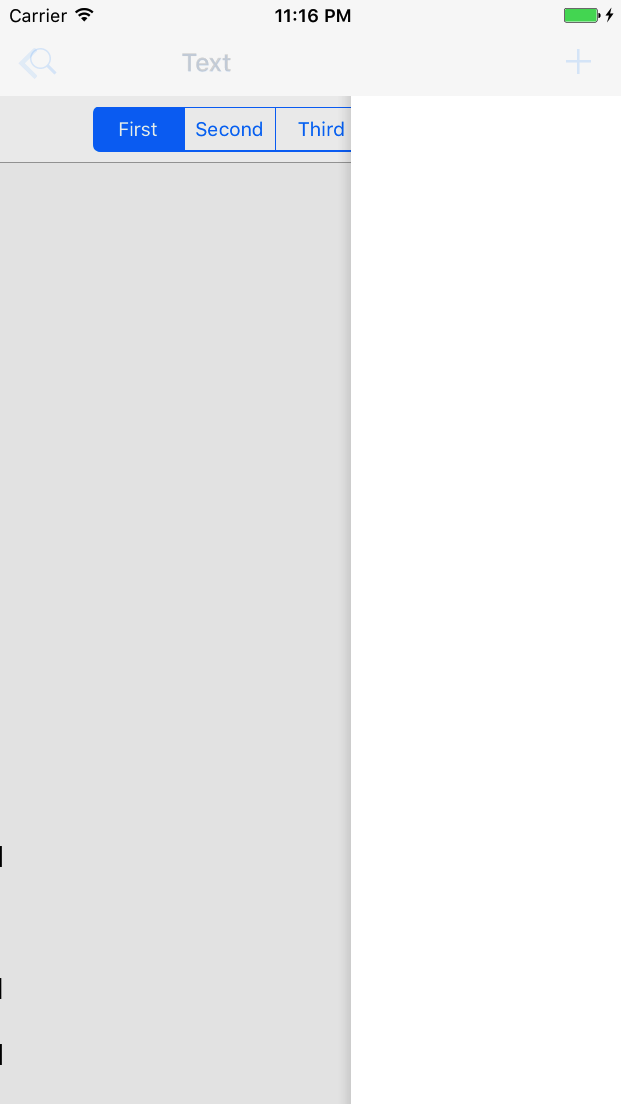Contrôle de l'uisegment en dessous de L'UINavigationbar dans iOS 7
Comment faire un UISegmentedControl comme partie d'un UINavigationBar ci-dessous? Est-il connecté au UINavigationBar ou s'agit-il d'une vue séparée complète juste ajoutée comme sous-vue au contrôleur de vue du UINavigationController . On dirait qu'il fait partie du UINavigationBar puisqu'il y a une ombre sous la barre.
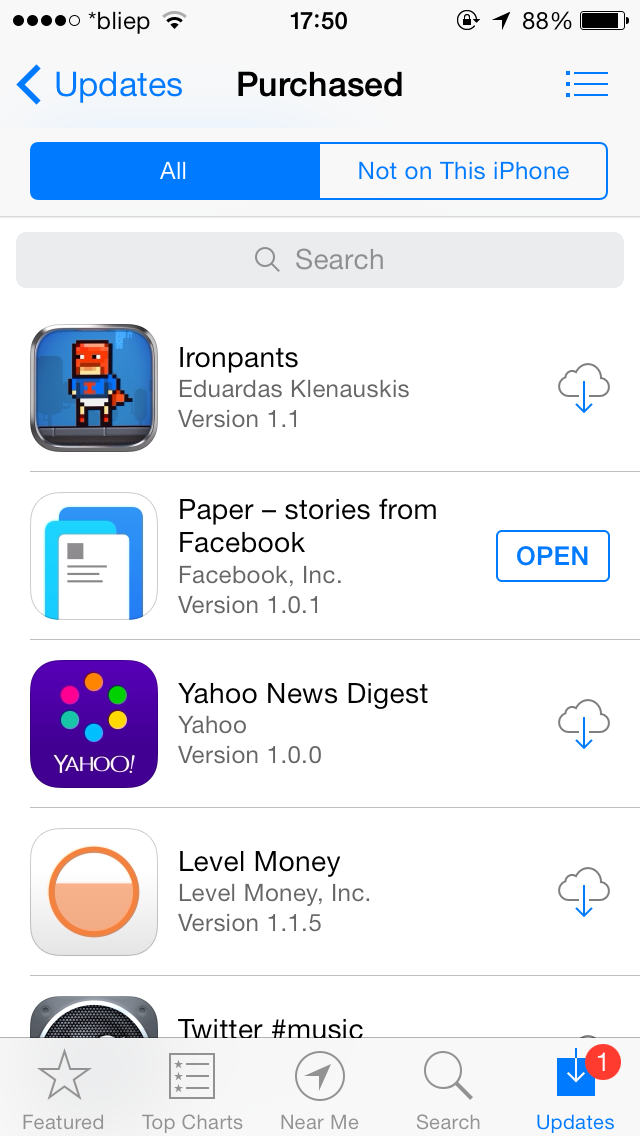
10 réponses
C'est un effet simple à accomplir.
tout d'Abord, placez un segment dans une barre d'outils. Placez cette barre d'outils juste sous la barre de navigation. Réglez le délégué de la barre d'outils sur votre contrôleur de vue, et retournez UIBarPositionTopAttached dans positionForBar: . Vous pouvez voir dans l'Application store, si vous exécutez un geste pop interactif, que la barre de segment ne se déplace pas la même que la barre de navigation. C'est parce qu'ils ne sont pas la même barre.
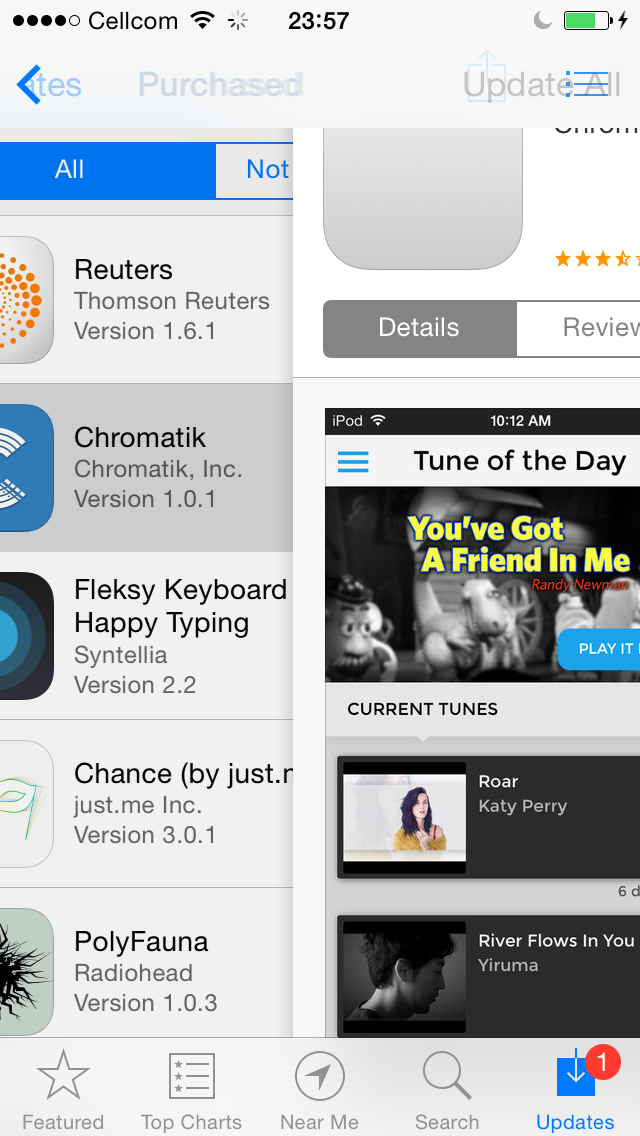
maintenant pour enlever la ligne des cheveux. Le " hairline "est un UIImageView qui est un sous-vue de la barre de navigation. Vous pouvez le trouver et le mettre comme caché. C'est ce que fait Apple dans son application native calendar, par exemple, ainsi que l'Application store. N'oubliez pas de le montrer lorsque l'affichage disparaît. Si vous jouez un peu avec les applications Apple, vous verrez que la ligne des cheveux est définie à caché sur viewWillAppear: et définie à montré dans viewDidDisappear: .
Pour atteindre le style de la barre de recherche, il suffit de définir la barre searchBarStyle à UISearchBarStyleMinimal .
maintenant pour enlever la ligne des cheveux. Le "hairline" est un UIImageView qui est un subview de la barre de navigation. Vous pouvez le trouver et le mettre comme caché. C'est ce que fait Apple dans son application native calendar, par exemple, ainsi que l'Application store. N'oubliez pas de le montrer lorsque l'affichage disparaît. Si vous jouez un peu avec les applications Apple, vous verrez que la ligne des cheveux est définie à hidden on viewWillAppear: et définie à shown in viewDidDisappear:.
une autre approche serait de chercher la ligne des cheveux et de la déplacer sous la barre d'outils ajoutée. Voici ce que j'ai trouvé.
@interface ViewController ()
@property (weak, nonatomic) IBOutlet UIToolbar *segmentbar;
@property (weak, nonatomic) UIImageView *navHairline;
@end
@implementation ViewController
#pragma mark - View Lifecycle
- (void)viewDidLoad
{
[super viewDidLoad];
// find the hairline below the navigationBar
for (UIView *aView in self.navigationController.navigationBar.subviews) {
for (UIView *bView in aView.subviews) {
if ([bView isKindOfClass:[UIImageView class]] &&
bView.bounds.size.width == self.navigationController.navigationBar.frame.size.width &&
bView.bounds.size.height < 2) {
self.navHairline = (UIImageView *)bView;
}
}
}
}
- (void)viewWillAppear:(BOOL)animated
{
[super viewWillAppear:animated];
[self _moveHairline:YES];
}
- (void)viewWillDisappear:(BOOL)animated
{
[super viewWillDisappear:animated];
[self _moveHairline:NO];
}
- (void)_moveHairline:(BOOL)appearing
{
// move the hairline below the segmentbar
CGRect hairlineFrame = self.navHairline.frame;
if (appearing) {
hairlineFrame.origin.y += self.segmentbar.bounds.size.height;
} else {
hairlineFrame.origin.y -= self.segmentbar.bounds.size.height;
}
self.navHairline.frame = hairlineFrame;
}
@end
j'ai aussi trouvé le code D'Apple NavBar Sample (Customizing UINavigationBar) très utile pour résoudre ce problème.
aussi être sûr de gérer le bord supérieur de L'UIToolbar , il pourrait apparaître et vous pourriez le confondre avec la ligne des cheveux du NavBar. J'ai aussi pour que L'UIToolbar ressemble exactement à la NavBar, vous voulez probablement ajuster les barres D'outils barTintColor alors.
Voici une approche Swift axée sur le protocole pour ce problème particulier, en se basant sur la réponse acceptée:
HideableHairlineViewController.swift
protocol HideableHairlineViewController {
func hideHairline()
func showHairline()
}
extension HideableHairlineViewController where Self: UIViewController {
func hideHairline() {
findHairline()?.hidden = true
}
func showHairline() {
findHairline()?.hidden = false
}
private func findHairline() -> UIImageView? {
return navigationController?.navigationBar.subviews
.flatMap { "151900920".subviews }
.flatMap { "151900920" as? UIImageView }
.filter { "151900920".bounds.size.width == self.navigationController?.navigationBar.bounds.size.width }
.filter { "151900920".bounds.size.height <= 2 }
.first
}
}
SampleViewController.swift
import UIKit
class SampleViewController: UIViewController, HideableHairlineViewController {
@IBOutlet private weak var toolbar: UIToolbar!
@IBOutlet private weak var segmentedControl: UISegmentedControl!
override func viewWillAppear(animated: Bool) {
super.viewWillAppear(animated)
hideHairline()
}
override func viewDidDisappear(animated: Bool) {
super.viewDidDisappear(animated)
showHairline()
}
}
// MARK: UIToolbarDelegate
extension SampleViewController: UIToolbarDelegate {
func positionForBar(bar: UIBarPositioning) -> UIBarPosition {
return .TopAttached
}
}
vous pouvez trouver barre de navigation avec UISegmentedControl dans le code D'échantillon D'Apple: https://developer.apple.com/library/ios/samplecode/NavBar/Introduction/Intro.html
Ou vous pouvez le créer par programmation, voici le code dans ma réponse dans l'autre thread ajouter le contrôle segmenté à la barre de navigation et garder le titre avec les boutons
je voulais faire la même chose.. Et voici:
1 - UINavigationBar sous-classe
//-------------------------
// UINavigationBarCustom.h
//-------------------------
#import <UIKit/UIKit.h>
@interface UINavigationBarCustom : UINavigationBar
@end
//-------------------------
// UINavigationBarCustom.m
//-------------------------
#import "UINavigationBarCustom.h"
const CGFloat MyNavigationBarHeightIncrease = 38.f;
@implementation UINavigationBarCustom
- (id)initWithCoder:(NSCoder *)aDecoder {
self = [super initWithCoder:aDecoder];
if (self) {
[self initialize];
}
return self;
}
- (id)initWithFrame:(CGRect)frame {
self = [super initWithFrame:frame];
if (self) {
[self initialize];
}
return self;
}
- (void)initialize {
// Set tittle position for top
[self setTitleVerticalPositionAdjustment:-(MyNavigationBarHeightIncrease) forBarMetrics:UIBarMetricsDefault];
}
- (CGSize)sizeThatFits:(CGSize)size {
// Increase NavBar size
CGSize amendedSize = [super sizeThatFits:size];
amendedSize.height += MyNavigationBarHeightIncrease;
return amendedSize;
}
- (void)layoutSubviews {
// Set buttons position for top
[super layoutSubviews];
NSArray *classNamesToReposition = @[@"UINavigationButton"];
for (UIView *view in [self subviews]) {
if ([classNamesToReposition containsObject:NSStringFromClass([view class])]) {
CGRect frame = [view frame];
frame.origin.y -= MyNavigationBarHeightIncrease;
[view setFrame:frame];
}
}
}
- (void)didAddSubview:(UIView *)subview
{
// Set segmented position
[super didAddSubview:subview];
if ([subview isKindOfClass:[UISegmentedControl class]])
{
CGRect frame = subview.frame;
frame.origin.y += MyNavigationBarHeightIncrease;
subview.frame = frame;
}
}
@end
2 - Réglez votre contrôleur de navigation avec la sous-classe

3 - ajouter votre UISegmentedControl dans navigationBar

4 - courir et S'amuser - >ne pas oublier de mettre la même couleur sur les deux "1519350920

la recherche de la source:
Apple a l'application échantillon spécifiquement pour cela. Il décrit la configuration d'une image d'ombre transparente et d'une image de fond colorée pour la barre de navigation et comment configurer une vue sous la barre de navigation. Il a également des exemples d'autres personnalisations de barre de navigation.
voir https://developer.apple.com/library/ios/samplecode/NavBar/Introduction/Intro.html
j'ai essayé d'enlever la ligne des cheveux en utilisant la méthode de @Simon mais cela n'a pas fonctionné. Je fais probablement quelque chose de mal parce que je suis super noob. Cependant, au lieu de supprimer la ligne, vous pouvez simplement la cacher en utilisant l'attribut hidden . Voici le code:
var hairLine: UIView = UIView()
override func viewDidLoad() {
super.viewDidLoad()
doneButton.enabled = false
for parent in self.navigationController!.navigationBar.subviews {
for childView in parent.subviews {
if childView is UIImageView && childView.bounds.size.width == self.navigationController!.navigationBar.frame.size.width {
hairLine = childView
}
}
}
}
override func viewWillAppear(animated: Bool) {
hairLine.hidden = true
}
override func viewWillDisappear(animated: Bool) {
hairLine.hidden = false
}
Espérons que cela aide quelqu'un!
UISegmentedControl ci-dessous UINavigationbar rapide 3/4
détails
Xcode 9.2, swift 4
Échantillon Complet
ViewController.swift
import UIKit
class ViewController: UIViewController {
@IBOutlet weak var tableView: UITableView!
@IBOutlet weak var navigationBarWithSegmentedControl: UINavigationBar!
fileprivate let barBackgroundColor = UIColor(red: 248/255, green: 248/255, blue: 248/255, alpha: 1.0)
override func viewDidLoad() {
super.viewDidLoad()
navigationBarWithSegmentedControl.barTintColor = barBackgroundColor
tableView.dataSource = self
tableView.delegate = self
}
override func viewWillAppear(_ animated: Bool) {
super.viewWillAppear(animated)
navigationController?.navigationBar.setBackgroundImage(UIImage(), for: .default)
navigationController?.navigationBar.shadowImage = UIImage()
navigationController?.navigationBar.barTintColor = barBackgroundColor
}
override func viewWillDisappear(_ animated: Bool) {
super.viewWillDisappear(animated)
navigationController?.navigationBar.setBackgroundImage(nil, for: .default)
navigationController?.navigationBar.shadowImage = nil
}
}
extension ViewController: UITableViewDataSource {
func numberOfSections(in tableView: UITableView) -> Int {
return 1
}
func tableView(_ tableView: UITableView, numberOfRowsInSection section: Int) -> Int {
return 100
}
func tableView(_ tableView: UITableView, cellForRowAt indexPath: IndexPath) -> UITableViewCell {
let cell = tableView.dequeueReusableCell(withIdentifier: "TableViewCell") as! TableViewCell
cell.label.text = "\(indexPath)"
return cell
}
}
extension ViewController: UITableViewDelegate {
func tableView(_ tableView: UITableView, didSelectRowAt indexPath: IndexPath) {
if let cell = tableView.cellForRow(at: indexPath) {
cell.isSelected = false
}
}
}
table Viewcell.swift
import UIKit
class TableViewCell: UITableViewCell {
@IBOutlet weak var label: UILabel!
}
Main.storyboard
<?xml version="1.0" encoding="UTF-8"?>
<document type="com.apple.InterfaceBuilder3.CocoaTouch.Storyboard.XIB" version="3.0" toolsVersion="13771" targetRuntime="iOS.CocoaTouch" propertyAccessControl="none" useAutolayout="YES" useTraitCollections="YES" colorMatched="YES" initialViewController="5TT-dT-dEr">
<device id="retina4_7" orientation="portrait">
<adaptation id="fullscreen"/>
</device>
<dependencies>
<deployment identifier="iOS"/>
<plugIn identifier="com.apple.InterfaceBuilder.IBCocoaTouchPlugin" version="13772"/>
<capability name="Constraints to layout margins" minToolsVersion="6.0"/>
<capability name="documents saved in the Xcode 8 format" minToolsVersion="8.0"/>
</dependencies>
<scenes>
<!--Text-->
<scene sceneID="tne-QT-ifu">
<objects>
<viewController id="BYZ-38-t0r" customClass="ViewController" customModule="stackoverflow_21887252" customModuleProvider="target" sceneMemberID="viewController">
<layoutGuides>
<viewControllerLayoutGuide type="top" id="y3c-jy-aDJ"/>
<viewControllerLayoutGuide type="bottom" id="wfy-db-euE"/>
</layoutGuides>
<view key="view" contentMode="scaleToFill" id="8bC-Xf-vdC">
<rect key="frame" x="0.0" y="0.0" width="375" height="603"/>
<autoresizingMask key="autoresizingMask" widthSizable="YES" heightSizable="YES"/>
<subviews>
<tableView clipsSubviews="YES" contentMode="scaleToFill" alwaysBounceVertical="YES" dataMode="prototypes" style="plain" separatorStyle="default" rowHeight="44" sectionHeaderHeight="28" sectionFooterHeight="28" translatesAutoresizingMaskIntoConstraints="NO" id="HLl-W2-Moq">
<rect key="frame" x="0.0" y="44" width="375" height="559"/>
<color key="backgroundColor" white="1" alpha="1" colorSpace="calibratedWhite"/>
<prototypes>
<tableViewCell clipsSubviews="YES" contentMode="scaleToFill" selectionStyle="default" indentationWidth="10" reuseIdentifier="TableViewCell" id="FKA-c2-G0Q" customClass="TableViewCell" customModule="stackoverflow_21887252" customModuleProvider="target">
<rect key="frame" x="0.0" y="28" width="375" height="44"/>
<autoresizingMask key="autoresizingMask"/>
<tableViewCellContentView key="contentView" opaque="NO" clipsSubviews="YES" multipleTouchEnabled="YES" contentMode="center" tableViewCell="FKA-c2-G0Q" id="Xga-fr-00H">
<rect key="frame" x="0.0" y="0.0" width="375" height="43.5"/>
<autoresizingMask key="autoresizingMask"/>
<subviews>
<label opaque="NO" userInteractionEnabled="NO" contentMode="left" horizontalHuggingPriority="251" verticalHuggingPriority="251" text="Label" textAlignment="natural" lineBreakMode="tailTruncation" baselineAdjustment="alignBaselines" adjustsFontSizeToFit="NO" translatesAutoresizingMaskIntoConstraints="NO" id="QW3-Hg-hU9">
<rect key="frame" x="15" y="11" width="345" height="21"/>
<fontDescription key="fontDescription" type="system" pointSize="17"/>
<nil key="textColor"/>
<nil key="highlightedColor"/>
</label>
</subviews>
<constraints>
<constraint firstAttribute="trailingMargin" secondItem="QW3-Hg-hU9" secondAttribute="trailing" id="Grx-nu-2Tu"/>
<constraint firstItem="QW3-Hg-hU9" firstAttribute="centerY" secondItem="Xga-fr-00H" secondAttribute="centerY" id="MIn-R2-wYE"/>
<constraint firstItem="QW3-Hg-hU9" firstAttribute="leading" secondItem="Xga-fr-00H" secondAttribute="leadingMargin" id="h6T-gt-4xk"/>
</constraints>
</tableViewCellContentView>
<color key="backgroundColor" red="0.0" green="0.0" blue="0.0" alpha="0.050000000000000003" colorSpace="custom" customColorSpace="sRGB"/>
<connections>
<outlet property="label" destination="QW3-Hg-hU9" id="QjK-i2-Ckd"/>
<segue destination="hcx-2g-4ts" kind="show" id="IGa-oI-gtf"/>
</connections>
</tableViewCell>
</prototypes>
</tableView>
<navigationBar contentMode="scaleToFill" translucent="NO" translatesAutoresizingMaskIntoConstraints="NO" id="8jj-w6-ZtU">
<rect key="frame" x="0.0" y="0.0" width="375" height="44"/>
<items>
<navigationItem id="q8e-Yy-ceD">
<nil key="title"/>
<segmentedControl key="titleView" opaque="NO" contentMode="scaleToFill" contentHorizontalAlignment="left" contentVerticalAlignment="top" segmentControlStyle="bar" selectedSegmentIndex="0" id="cHD-bv-2w7">
<rect key="frame" x="96.5" y="7" width="182" height="30"/>
<autoresizingMask key="autoresizingMask" flexibleMaxX="YES" flexibleMaxY="YES"/>
<segments>
<segment title="First"/>
<segment title="Second"/>
<segment title="Third"/>
</segments>
</segmentedControl>
</navigationItem>
</items>
</navigationBar>
</subviews>
<color key="backgroundColor" red="1" green="1" blue="1" alpha="1" colorSpace="custom" customColorSpace="sRGB"/>
<constraints>
<constraint firstItem="8jj-w6-ZtU" firstAttribute="trailing" secondItem="HLl-W2-Moq" secondAttribute="trailing" id="1vT-ta-AuP"/>
<constraint firstItem="8jj-w6-ZtU" firstAttribute="leading" secondItem="8bC-Xf-vdC" secondAttribute="leading" id="BJE-BC-XcB"/>
<constraint firstItem="8jj-w6-ZtU" firstAttribute="top" secondItem="y3c-jy-aDJ" secondAttribute="bottom" id="Boi-dN-awt"/>
<constraint firstItem="HLl-W2-Moq" firstAttribute="bottom" secondItem="wfy-db-euE" secondAttribute="top" id="W1n-m1-EOH"/>
<constraint firstAttribute="trailing" secondItem="8jj-w6-ZtU" secondAttribute="trailing" id="ihc-9p-71l"/>
<constraint firstItem="HLl-W2-Moq" firstAttribute="top" secondItem="8jj-w6-ZtU" secondAttribute="bottom" id="pFk-pU-y7j"/>
<constraint firstItem="8jj-w6-ZtU" firstAttribute="leading" secondItem="HLl-W2-Moq" secondAttribute="leading" id="yjf-7o-t2m"/>
</constraints>
</view>
<navigationItem key="navigationItem" title="Text" id="yrt-M7-PAX">
<barButtonItem key="leftBarButtonItem" systemItem="search" id="wrz-DS-FdJ"/>
<barButtonItem key="rightBarButtonItem" systemItem="add" id="LnB-Ci-YnO"/>
</navigationItem>
<connections>
<outlet property="navigationBarWithSegmentedControl" destination="8jj-w6-ZtU" id="Ggl-xb-fmj"/>
<outlet property="tableView" destination="HLl-W2-Moq" id="hEO-2U-I9k"/>
</connections>
</viewController>
<placeholder placeholderIdentifier="IBFirstResponder" id="dkx-z0-nzr" sceneMemberID="firstResponder"/>
</objects>
<point key="canvasLocation" x="894" y="791"/>
</scene>
<!--View Controller-->
<scene sceneID="Bi7-4l-uRN">
<objects>
<viewController id="hcx-2g-4ts" sceneMemberID="viewController">
<layoutGuides>
<viewControllerLayoutGuide type="top" id="NSV-kw-fuz"/>
<viewControllerLayoutGuide type="bottom" id="aze-le-h11"/>
</layoutGuides>
<view key="view" contentMode="scaleToFill" id="1nd-qq-kDT">
<rect key="frame" x="0.0" y="0.0" width="375" height="603"/>
<autoresizingMask key="autoresizingMask" widthSizable="YES" heightSizable="YES"/>
<subviews>
<view contentMode="scaleToFill" translatesAutoresizingMaskIntoConstraints="NO" id="k7W-CB-tpA">
<rect key="frame" x="0.0" y="0.0" width="375" height="603"/>
<color key="backgroundColor" white="1" alpha="1" colorSpace="calibratedWhite"/>
</view>
</subviews>
<color key="backgroundColor" white="0.66666666666666663" alpha="0.5" colorSpace="calibratedWhite"/>
<constraints>
<constraint firstAttribute="trailing" secondItem="k7W-CB-tpA" secondAttribute="trailing" id="1t2-Bi-dR7"/>
<constraint firstItem="k7W-CB-tpA" firstAttribute="bottom" secondItem="aze-le-h11" secondAttribute="top" id="Fnm-UL-geX"/>
<constraint firstItem="k7W-CB-tpA" firstAttribute="leading" secondItem="1nd-qq-kDT" secondAttribute="leading" id="bKV-7A-hz0"/>
<constraint firstItem="k7W-CB-tpA" firstAttribute="top" secondItem="NSV-kw-fuz" secondAttribute="bottom" id="cFH-7i-vAm"/>
</constraints>
</view>
</viewController>
<placeholder placeholderIdentifier="IBFirstResponder" id="jPK-Z9-yvJ" userLabel="First Responder" sceneMemberID="firstResponder"/>
</objects>
<point key="canvasLocation" x="1566" y="791"/>
</scene>
<!--Navigation Controller-->
<scene sceneID="1Pc-qt-rnW">
<objects>
<navigationController automaticallyAdjustsScrollViewInsets="NO" id="5TT-dT-dEr" sceneMemberID="viewController">
<toolbarItems/>
<navigationBar key="navigationBar" contentMode="scaleToFill" translucent="NO" id="lPt-hx-iar">
<rect key="frame" x="0.0" y="20" width="375" height="44"/>
<autoresizingMask key="autoresizingMask"/>
</navigationBar>
<nil name="viewControllers"/>
<connections>
<segue destination="BYZ-38-t0r" kind="relationship" relationship="rootViewController" id="6b8-br-zSy"/>
</connections>
</navigationController>
<placeholder placeholderIdentifier="IBFirstResponder" id="u7U-GH-NHe" userLabel="First Responder" sceneMemberID="firstResponder"/>
</objects>
<point key="canvasLocation" x="140" y="791.15442278860576"/>
</scene>
</scenes>
</document>
Résultats
il y a plusieurs façons de faire ce que vous avez demandé. Le plus facile étant bien sûr de le créer dans l'Interface builder mais je suppose que ce n'est pas ce que vous aviez à l'esprit. J'ai créé un exemple de l'image affichée ci-dessus. Ce n'est pas exactement la même chose, mais vous pouvez jouer avec les nombreuses propriétés pour obtenir l'apparence et la sensation de ce que vous recherchez.
dans le ViewController.h
#import <UIKit/UIKit.h>
@interface ViewController : UIViewController <UITableViewDataSource, UITableViewDelegate, UISearchBarDelegate>
@end
In le ViewController.m
#import "ViewController.h"
@interface ViewController ()
@property (strong, nonatomic) UISegmentedControl *mySegmentControl;
@property (strong, nonatomic) UISearchBar *mySearchBar;
@property (strong, nonatomic) UITableView *myTableView;
@property (strong, nonatomic) NSMutableArray *tableDataArray;
@end
@implementation ViewController
- (void)viewDidLoad {
[super viewDidLoad];
// create a custom UIView
UIView *myView = [[UIView alloc] initWithFrame:CGRectMake(0, 64, 320, 84)];
myView.tintColor = [UIColor lightGrayColor]; // change tiny color or delete this line to default
// create a UISegmentControl
self.mySegmentControl = [[UISegmentedControl alloc] initWithItems:[NSArray arrayWithObjects:@"All", @"Not on this iPhone", nil]];
self.mySegmentControl.selectedSegmentIndex = 0;
[self.mySegmentControl addTarget:self action:@selector(segmentAction:) forControlEvents:UIControlEventValueChanged];
self.mySegmentControl.frame = CGRectMake(20, 10, 280, 30);
[myView addSubview:self.mySegmentControl]; // add segment control to custom view
// create UISearchBar
self.mySearchBar = [[UISearchBar alloc] initWithFrame:CGRectMake(0, 40, 320, 44)];
[self.mySearchBar setDelegate:self];
self.mySearchBar.searchBarStyle = UISearchBarStyleMinimal;
[myView addSubview:self.mySearchBar]; // add search bar to custom view
[self.view addSubview:myView]; // add custom view to main view
// create table data array
self.tableDataArray = [[NSMutableArray alloc] initWithObjects:
@"Line 1",
@"Line 2",
@"Line 3",
@"Line 4",
@"Line 5",
@"Line 6",
@"Line 7",
@"Line 8",
@"Line 9",
@"Line 10",
@"Line 11",
@"Line 12", nil];
self.myTableView = [[UITableView alloc] initWithFrame:CGRectMake(0, 160, 320, 320)];
[self.myTableView setDataSource:self];
[self.myTableView setDelegate:self];
[self.view addSubview:self.myTableView]; // add table to main view
}
-(void)searchBarSearchButtonClicked:(UISearchBar *)searchBar {
[searchBar resignFirstResponder];
NSLog(@"search text = %@",searchBar.text);
// code for searching...
}
- (NSInteger)numberOfSectionsInTableView:(UITableView *)tableView {
return 1;
}
-(NSInteger)tableView:(UITableView *)tableView numberOfRowsInSection:(NSInteger)section {
return [self.tableDataArray count];
}
- (UITableViewCell *)tableView:(UITableView *)tableView cellForRowAtIndexPath:(NSIndexPath *)indexPath {
static NSString *CellIdentifier = @"Cell";
UITableViewCell *cell = [tableView dequeueReusableCellWithIdentifier:CellIdentifier];
if (cell == nil)
{
cell = [[UITableViewCell alloc] initWithStyle:UITableViewCellStyleSubtitle reuseIdentifier:CellIdentifier];
}
cell.textLabel.text = [self.tableDataArray objectAtIndex:indexPath.row];
return cell;
}
- (void)tableView:(UITableView *)tableView didSelectRowAtIndexPath:(NSIndexPath *)indexPath {
NSLog(@"Selected table item: %@",[self.tableDataArray objectAtIndex:indexPath.row]);
// do something once user has selected a table cell...
}
-(void)segmentAction:(id)sender {
NSLog(@"Segment control changed to: %@",[self.mySegmentControl titleForSegmentAtIndex:[self.mySegmentControl selectedSegmentIndex]]);
// do something based on segment control selection...
}
- (void)didReceiveMemoryWarning {
[super didReceiveMemoryWarning];
// Dispose of any resources that can be recreated.
}
@end
displaysSearchBarInNavigationBar est la façon d'afficher une barre de recherche ainsi que sa barre de portée dans la barre de navigation.
vous devez juste cacher la barre de recherche chaque fois que vous montrez le titre personnalisé
